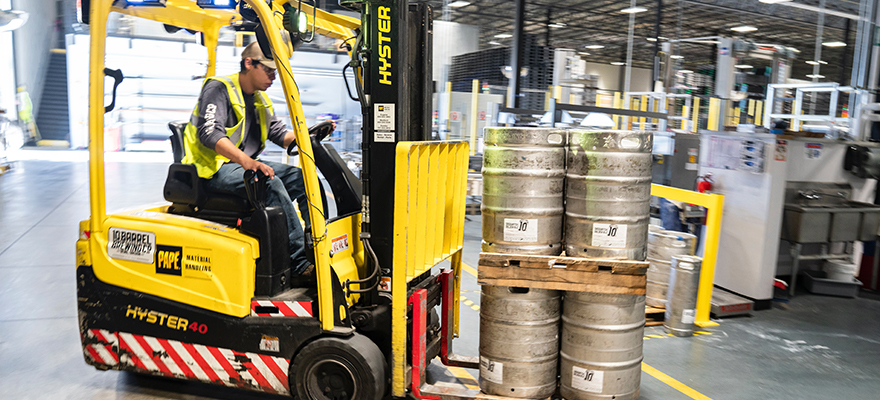August 13, 2018
 Interview with Lisa Harrington, global logistics author, supply chan consultant, senior research scholar, and John Goldschmidt, Head of Product Growth at Qlicket
Interview with Lisa Harrington, global logistics author, supply chan consultant, senior research scholar, and John Goldschmidt, Head of Product Growth at Qlicket
As the company’s solution and customer base continues to grow, John regularly meets with managers and HR professionals who are seeking to make their frontline workforce safer, more satisfied, and more productive. He is always available via email at johng@qlicket.com.
This is Part 1 of a two part series. Part 1 looks at the talent shortage on the supply chain front lines – the distribution center – how severe it is and what’s causing it. Part 2 will explore what companies can do to help solve the front-line worker shortage problem.
We had a moment to sit down with Lisa Harrington, who is the president of a strategic research and consulting firm called LHarrington Group. Her company focuses on global supply chain strategy, operations, and technology, and her list of clients includes DHL, FedEx, the US Department of Defense, Caterpillar, Intel, Microsoft, BP, Lockheed Martin, NASA, Honeywell, and others. She is also a senior research scholar at the Center for Public Policy at the University of Maryland, and a former faculty number at Maryland’s Robert H. Smith School of Business. She’s a thought leader who writes extensively about global logistics and supply chain matters- her articles and books are published around the world. So, we were lucky to get a few moments of her time to talk to her about the labor pool and what can be done to attract and retain talent.
JOHN:
Welcome Lisa, thank you so much for being here to lend a bit of your perspective to the first Qlicket Q&A.
LISA:
It’s a pleasure to be here.
JOHN:
Wherever I go to transportation and logistics professional events- trade shows, conferences, networking, etc.- everybody is talking about the level of employee turnover that exists. It’s top of mind for many organizations and everyone has recognized a shift from talent being an operational requirement to a strategic asset. This is why we thought it would be a great time to interview an expert such as you.
So, what exactly is going on with jobs in the supply chain?
LISA:
I’ve spent much the last year researching the issue of supply chain talent and found that there’s a huge labor shortage that’s rapidly reaching crisis proportions – in pretty much every industry and every geography. This is true in virtually every job category, but especially serious at the front-line level, meaning warehouse workers.
Why is this happening? One big reason is rising service expectations. Customers in every industry have come to expect better and better service from their suppliers, retailers and distributors. E-commerce is a big driver of this trend.
The bottom line is, customers want their products fast, they want the order to be perfect, they want damage-free, and – the newest requirement – they want complete, end-to-end visibility into their orders.
To give customers what they want – especially the speed – companies are redesigning their supply chain networks to get physically closer to the customer. The point is to speed up service. So, they’re building more, but smaller distribution centers. They’re going from two or three mega-centers, to eight, 10, 12 or even more DCs.
Customers win big with this strategy. But it does have a down side. It means companies need more front-line people. But not just people who know how to drive a forklift or pack a box. They need people who also know how to work with technologies like robotics and vision picking. People who are willing and able to constantly learn and change with the job. That’s not an easy combination to find.
JOHN:
This seems like a pretty big change for supply chains. Is there a name for this trend?
LISA:
There sure is.
We call it the “Amazon effect,” and it’s spreading like wildfire.
Make no mistake. The Amazon effect isn’t just a B to C e-commerce thing. It’s bleeding over into B to B – fast. Even to “old line” industries like heavy manufacturing.
The bottom line is, customers in B to C and B to B expect more in every single aspect of service, in every single industry.
JOHN:
Very interesting. So, what can be done to combat this?
LISA:
Well typically the folks who enter the supply chain front line are millennials. They’re familiar with technology – at least computers and smart phones. They don’t want to work in a place where there’s old style technology or worse, no technology. A company invests in warehouse technology is a cooler place to work – a place they can brag about. Also, a place that probably values its employees more.
This puts companies that don’t invest in warehouse technologies like vision picking, robotics, autonomous vehicles and virtual reality are at a real disadvantage in terms of attracting workers.
So, if I’m a warehouse worker and I work in a warehouse that is investing in cool technologies, my job is more interesting, and I can do it better – work faster and smarter.
That’s fine. But is that enough? Is the technology and perhaps a bump in pay and a little bump in benefits enough? Probably not.
Typically, what we’ve heard is that these workers complain that they’re never listened to. Even with all the bells and whistles, and a little bit better pay, they still feel like they have little or no control over their work and their work environment. They feel like management views them – and their opinions – as an afterthought. They see management paying much more attention to filling, keeping and making happy the data analytics roles, the mid-manager roles, etc. They neglect the people who are actually doing the work of the supply chain. Needless to say, being considered an afterthought doesn’t sit well with millennials.
What can companies do to solve this problem – to attract, retain and develop their front-line employees? Find out in Part 2.
If you have any additional thoughts about turnover and employee engagement in blue collar work places, please feel free to comment below!


